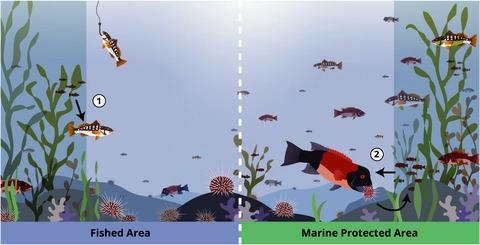当前位置:
X-MOL 学术
›
Ecol. Lett.
›
论文详情
Our official English website, www.x-mol.net, welcomes your
feedback! (Note: you will need to create a separate account there.)
No-take marine protected areas enhance the benefits of kelp-forest restoration for fish but not fisheries
Ecology Letters ( IF 7.6 ) Pub Date : 2022-05-21 , DOI: 10.1111/ele.14023 Jess K Hopf 1 , Jennifer E Caselle 2 , J Wilson White 1, 3
Ecology Letters ( IF 7.6 ) Pub Date : 2022-05-21 , DOI: 10.1111/ele.14023 Jess K Hopf 1 , Jennifer E Caselle 2 , J Wilson White 1, 3
Affiliation

|
Kelp habitat restoration is gaining traction as a management action to support recovery in areas affected by severe disturbances, thereby ensuring the sustainability of ecosystem services. Knowing when and where to restore is a major question. Using a single-species population model, we consider how restoring inside marine protected areas (MPAs) might benefit coastal fish populations and fisheries. We found that MPAs can greatly enhance the population benefits of restoration but at a small cost to fishery yields. Generally, restoring inside MPAs had a better overall gains-loss outcome, especially if the system is under high fishing pressure or severe habitat loss. However, restoring outside became preferable when predatory fish indirectly benefit kelp habitats. In either case, successful restoration actions may be difficult to detect in time-series data due to complex transient dynamics. We provide context for setting management goals and social expectations for the ecosystem service implications of restoration in MPAs.
中文翻译:

禁捕海洋保护区增强了海带森林恢复对鱼类的好处,但对渔业没有好处
海带栖息地恢复作为一项管理行动越来越受到关注,以支持受严重干扰影响地区的恢复,从而确保生态系统服务的可持续性。知道何时何地恢复是一个主要问题。使用单一物种种群模型,我们考虑海洋保护区 (MPA) 内的恢复如何有利于沿海鱼类种群和渔业。我们发现海洋保护区可以极大地提高恢复带来的人口效益,但对渔业产量的影响很小。一般来说,恢复海洋保护区内的总体收益-损失结果更好,特别是当系统处于高捕捞压力或严重栖息地丧失的情况下。然而,当掠食性鱼类间接有益于海带栖息地时,外部恢复就变得更可取。在任何一种情况下,由于复杂的瞬态动态,成功的恢复操作可能很难在时间序列数据中检测到。我们为海洋保护区恢复的生态系统服务影响设定管理目标和社会期望提供背景。
更新日期:2022-05-21
中文翻译:

禁捕海洋保护区增强了海带森林恢复对鱼类的好处,但对渔业没有好处
海带栖息地恢复作为一项管理行动越来越受到关注,以支持受严重干扰影响地区的恢复,从而确保生态系统服务的可持续性。知道何时何地恢复是一个主要问题。使用单一物种种群模型,我们考虑海洋保护区 (MPA) 内的恢复如何有利于沿海鱼类种群和渔业。我们发现海洋保护区可以极大地提高恢复带来的人口效益,但对渔业产量的影响很小。一般来说,恢复海洋保护区内的总体收益-损失结果更好,特别是当系统处于高捕捞压力或严重栖息地丧失的情况下。然而,当掠食性鱼类间接有益于海带栖息地时,外部恢复就变得更可取。在任何一种情况下,由于复杂的瞬态动态,成功的恢复操作可能很难在时间序列数据中检测到。我们为海洋保护区恢复的生态系统服务影响设定管理目标和社会期望提供背景。











































 京公网安备 11010802027423号
京公网安备 11010802027423号